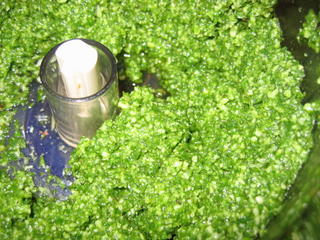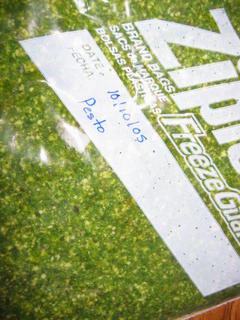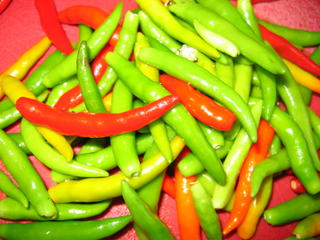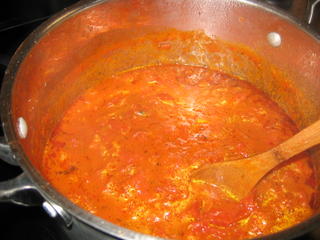Preserving the Harvest: Basil, Chiles and Tomatoes, Oh, My!
 Summer is officially gone; October’s chill is in the air, the sun has hidden her face behind a veil of grey clouds, and night descends earlier with each turn of the Earth. The trees are flecked with scarlet and gold, and the air thrums with the beat of wings and the calls of geese as they fly toward warmer climes.
Summer is officially gone; October’s chill is in the air, the sun has hidden her face behind a veil of grey clouds, and night descends earlier with each turn of the Earth. The trees are flecked with scarlet and gold, and the air thrums with the beat of wings and the calls of geese as they fly toward warmer climes.
But the gardens of Athens county are yet prolific; the Farmer’s Market is filled with produce that sings to summer’s faded glory while trumpeting the autumn harvest. Wedding bouquet bunches of basil are cheaper than flowers, chiles of every size and color tempt from baskets and boxes, and tomatoes, both ripe and green are to be had from every farmer for next to nothing.
Of course, I have been buying these last hurrahs of summer up; for the past several weeks, at every trip to the market–generally a twice weekly journey–I pick up at least two bunches of basil, sometimes three. When I get home, I plunk them into a quart-sized recycled yogurt container of water and sit them on the counter to wait until I have a few spare moments.
 When I am not busy with dinner or with anything else in the kitchen, I pull out the Cuisinart and make a batch or two of pesto. It is the simplest thing in the world to do: first, I toast some pine nuts (if I have them, and usually do), and throw them into the processor bowl. Then I peel garlic, and toss it in as well. Then I pluck all the leaves from the basil and throw that in on top, then grate some parmesan cheese on top of it all. I sprinkle about a half teaspoon of salt and some generous grindings of black pepper over the cheese, put the lid on, and pick up the bottle of extra virgin olive oil.
When I am not busy with dinner or with anything else in the kitchen, I pull out the Cuisinart and make a batch or two of pesto. It is the simplest thing in the world to do: first, I toast some pine nuts (if I have them, and usually do), and throw them into the processor bowl. Then I peel garlic, and toss it in as well. Then I pluck all the leaves from the basil and throw that in on top, then grate some parmesan cheese on top of it all. I sprinkle about a half teaspoon of salt and some generous grindings of black pepper over the cheese, put the lid on, and pick up the bottle of extra virgin olive oil.
 Then, I turn on the machine and start pouring the oil in a slow, steady drizzle. When a thick, brilliant green paste results, I stop the oil and the food processor. When I make pesto for freezing, I don’t make it as liquid as I do normally, because I never know what I am going to do with it. If I am going to use it for a pasta sauce, liquidy is better, but if I am going to use it to season a soup or as a pizza topping or to stuff a chicken breast, then I want it to be fairly thick. It is easier to thin a paste than to add bulk, so, I leave the pesto fairly thick.
Then, I turn on the machine and start pouring the oil in a slow, steady drizzle. When a thick, brilliant green paste results, I stop the oil and the food processor. When I make pesto for freezing, I don’t make it as liquid as I do normally, because I never know what I am going to do with it. If I am going to use it for a pasta sauce, liquidy is better, but if I am going to use it to season a soup or as a pizza topping or to stuff a chicken breast, then I want it to be fairly thick. It is easier to thin a paste than to add bulk, so, I leave the pesto fairly thick.
Then it is a simple matter of scooping it with a silicone spatula into a couple or three freezer bags. (Here’s a big tip–label it first with a Sharpie pen–it is easier to write legibly if there is nothing in the bag.) After the bag has as much as I want in it (about a cup), I lay it flat on the counter, and squeeze out the air by spreading the pesto into a smoothly between the two pieces of plastic, then zip the bag shut. These stack easily in the freezer and take up very little room. Also, if you only want a little bit of pesto you can easily break or cut off a hunk and put the rest of it, still frozen, back into the freezer.
I have tried freezing it in ice cube trays and then popping out the green cubes and packing them in bags, but it really is a big pain in the butt to get the pesto out of the tray. It is pretty messy getting it, too, now that I think on it.
At this point, I have a dozen batches of pesto safely nestled in the freezer, waiting to bring the voluptuous flavor of summer into a blustery winter evening.
 Chiles bring the heat of summer to my winter kitchen every year. I used to process them by mincing or chopping them up and then packing them in bags, but I found that it was hard for me to judge how much chile to use for any given recipe. I never measure chiles by teaspoons, but always by whole or half chile increments.
Chiles bring the heat of summer to my winter kitchen every year. I used to process them by mincing or chopping them up and then packing them in bags, but I found that it was hard for me to judge how much chile to use for any given recipe. I never measure chiles by teaspoons, but always by whole or half chile increments.
So, this year, I tried something new and just washed and dried the chiles, then removed their stems and stuck them in bags and froze them whole, separated by variety.
 And what a variety there was: I ended up with a quart of Thai bird chiles, half a quart of serranos, a quart of ripe and green jalapenos, a quart of habaneros and a quart of cayenne.
And what a variety there was: I ended up with a quart of Thai bird chiles, half a quart of serranos, a quart of ripe and green jalapenos, a quart of habaneros and a quart of cayenne.
 When we made kofta the other night, I used a whole, frozen Thai chile in it, to see how my new trick worked out, and it was easily chopped up in the Sumeet, and added just the
When we made kofta the other night, I used a whole, frozen Thai chile in it, to see how my new trick worked out, and it was easily chopped up in the Sumeet, and added just the
right amount of flavor to the curry paste. I
think it worked marvelously.
I will have to try one of the larger chiles, like the green jalapenos, to see if I can cut them still frozen, or if I need to let them thaw a bit first.
I also still have some poblanos and New Mexico green chiles to process; those will be a bit more complicated. I have to light the grill (which means I have to wait for the rain to stop) and blacken them completely on all sides, then let them steam, covered in a bowl. When they are cool enough to handle, I will peel off the burned skin, and then cut the roasted flesh into strips and pack those into freezer bags and use them in Mexican sauces over the winter.
I was given a huge bag of fresh tomatoes from Morganna’s friend Donny’s garden. His Mom had enough tomatoes, and wanted to be rid of them, so I was the thankful recipient of about twelve pounds of them. Since Zak and Morganna only really like tomatoes in salsa or pasta sauces, I decided to use them to make a basic marinara, and freeze that to use as the basis for any number of pasta dinners this coming winter.
Going from fresh tomatoes to sauce is kind of a messy journey, which is why we only have an illustration of the final product. While I was in the midst of peeling and seeding these very ripe, rich red babies, I was up to my elbows in tomato juice. Since Morganna was still visiting her grandfather and Zak was doing some computer work for a friend, there was no one else to take pictures, so you will have to make do with my description of the process, and hope that I luck into another big basket of tomatoes on a day when I have another photographer handy.
In that case, I will post more photographs.
But, at the end of all the tomato-juice follies, I ended up with three quarts of basic marinara that I can dig out of the freezer some night this winter when I have no clue what to cook, and just want something quicky and easy.
Next year, I think I will actually start canning some of the harvest. I really enjoy making fresh tomato sauces and salsas, even if it is messy, and I love the flavor of fresh jellies and jams. I have the equipment to start canning, so why not? I used to help my Grandma do canning and freezing all the time.
But not this year. This year, it is up to my friend the freezer and I to try and preserve the brilliant colors, flavors and scents of summer, so that when the icy wind blows and snow pours from the sky, I can cook up a meal that will remind us that warmth and sunlight always follows winter’s chill embrace.
Ingredients:
10-12 pounds fresh tomatoes
2 1/2 tablespoons olive oil
1 large onion, diced finely
1 red sweet pepper, diced finely
1 teaspoon dried thyme
2 teaspoons dried oregano
1 teaspoon dried powdered rosemary
1 tablespoon dried basil
1/2 teaspoon dried marjoram
1/4 teaspoon ground fennel seeds
pinch red pepper flakes
1 head garlic, minced
1 cup dry red wine
salt and pepper to taste
2 bay leaves
1 can tomato paste (optional)
fresh herbs (optional)
Method:
Bring a large pot of water to a boil. Wash the tomatoes thoroughly.
On the bottom of the tomatoes, opposite the stem, score a small X just through the skin with a paring knife. When all the tomatoes are scored, drop them into the boiling water, and let cook for about a minute. Drain into a colander, and when cool enough to handle, pick at the raised skin where you scored the tomatoes, and peel the skin off.
After they are skinned, cut out the core with a paring knife. To seed the tomatoes, cut them in half horizontally–between the stem and the bottom. This exposes all the seed pockets. Holding the tomato halves upside down over a bowl, use your fingers to scoop the seeds from the pockets. (Don’t get anal retentive about this–some seeds will get away from you. Don’t worry, no one will die from a few seeds in your pasta sauce.)
Discard the seeds, and set the now gnarly-looking, deformed tomatoes into a bowl until it is time to put them in the sauce.
In a big, heavy-bottomed pot, heat olive oil. Add onions and pepper and cook until golden. Add all dried herbs and spices, and continue cooking and stirring until the onions begin to brown slightly. At this point, add the garlic, and stir until the garlic is very fragrant.
Pour in the wine, and allow the alcohol to boil off.
When the alcohol is gone, add the tomatoes: if you want to, you can dice them, but I like chunky sauce, so I just pick them up in my hands, and holding them over the pot, squish them, pulverizing them into mushy bits, then letting them fall into the pot. Add salt and pepper and bay leaves; when you add them, keep in mind that you are going to simmer away most of the water, so do not salt so it tastes right at that moment. Undersalting is the rule of the day. If you want, you can add tomato paste to thicken the sauce even more, and to add a sweeter tomato flavor.
Turn the heat down to low, and simmer until the juice is reduced down, and the sauce is as thick as you like it.
When it is done, mince up as many fresh herbs as you like and add to the sauce and correct for salt.
This makes about three quarts of sauce. To freeze, cool down sauce, pack in bags, leaving about one and a half inches of headspace. Carefully push out the air and seal the bags closed, then lay them flat in the freezer. This ensures that they will take up very little room once they are frozen and they will stack nicely.
Note:
Roma or plum tomatoes make the best pasta sauces, but I was given just plain old garden tomatoes. And as ripe and wonderful as they were, they made a lovely sauce.
You can add other vegetables to this, but I like making a plain sauce and then later, when I use it, I can customize it into a mushroom sauce, a veggie sauce or a spicy arrabiata, depending on what I add to it after it is thawed. Or, I can brown some sausage, or make meatballs, or ground pork or veal for a quick meaty sauce.
10 Comments
RSS feed for comments on this post.
Sorry, the comment form is closed at this time.
Powered by WordPress. Graphics by Zak Kramer.
Design update by Daniel Trout.
Entries and comments feeds.





I’ve frozen jalapenos whole before, and they worked well in soups later. I couldn’t cut them while they were frozen, though.
Comment by Castiron — October 11, 2005 #
I pulled out one of the frozen jalapenos and used it in some salsa verde today; I was able to cut it fine frozen, but then, I have super sharp knives. And if the knives didn’t work, I’d get out the cleaver and really have at it.
😉
I also roasted and peeled whole poblanos and New Mexico chiles and froze them. I need to get some more of those, but I now have a large, diverse assortment of chiles for the winter. I also roasted corn on the grill and cut it from the cob and froze it to use in soups, chiles and as fillings for enchiladas, burritos and other Mexican dishes.
I really should get into canning next year–I feel such an accomplishment looking at the small amount of stuff I have put up in the freezer–I can only imagine how I would feel looking at a pantry full of home-canned sauces, salsas, pickles, preserves, jellies and vegetables.
Comment by Barbara Fisher — October 11, 2005 #
Don’t know if you’re interested in this, but I like to wash and toss the tomatoes into the frezeer (in a plastic baggie) when I’ve got a bunch of them. I can pull them out and let them defrost for a few minutes and the skin comes right off, no need to boil water (I cheat and freeze a whole cabbage for leaves for cabbage rolls too)
Comment by dibranchia — October 11, 2005 #
But, but – it’s not really marinara withough anchovy is it?
That said, I LOVE making tomato sauce – haven’t made it with fresh tomatoes in ages, though. (Usually use a mix of diced and crushed canned tomatoes.)
Hm – time to plant a couple more romas! Can’t have too many!
Comment by empress cat — May 5, 2006 #
You are correct, Empress, but for those who come to my house and want to eat vegetarian, I just make it anchovy free. Then, when I thaw it–I can always add anchovy to it, if no vegetarian sorts are eating it!
Comment by Barbara — May 6, 2006 #
[…] Several different ways, indeed, though pesto was the very first–it had to be. The last of my frozen pesto was gone–and as good as it is in the deep midwinter, the frozen pesto still is not as wonderful as the stuff is fresh. I bought up bunches of green garlic to go in the pesto, and broke out the Parmesan cheese, olive oil and pinenuts. (From Italy, California and somewhere out west, respectively–not local, but until Ohio producers start making real Parmesan, growing and pressing stupendous olives and growing me some pinenuts–and these things, due to climate, are not going to happen–I am never going to have truly local authentic pesto. That is fine with me, since most of my staple items are coming in from local producers at this point.) […]
Pingback by Tigers & Strawberries » The First Pesto of the Year! — May 8, 2006 #
dibranchia, Do you blanche the whole cabbage before you freeze it?
Comment by Marion — July 8, 2007 #
Marion, you cut the cabbage in whatever way you want to freeze it and then blanch it. If you try to blanch it whole it will not really work.
The largest pieces I ever saw my grandmother blanch were wedges cut from the head.
Comment by Barbara — July 8, 2007 #
do you export frozen pesto? please reply
Comment by Maria Pesavento — February 28, 2008 #
Maria–no. I freeze pesto at home for home use, and show how you can do it in your own home.
Comment by Barbara — February 28, 2008 #